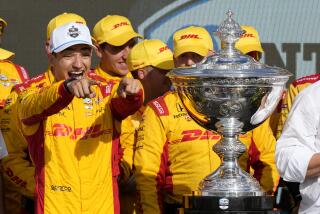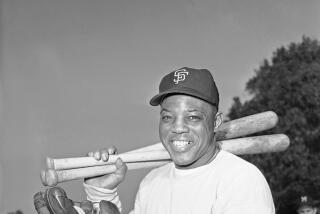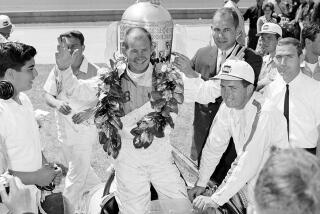INDIANAPOLIS 500 : Mears Will Use Healthy Fear in Bid for 4th Win
INDIANAPOLIS — In 11 trips to Indianapolis Motor Speedway, Rick Mears has started from the pole four times and won the 500 three times.
But perhaps a more revealing statistic about the Bakersfield veteran is that in 1,757 laps he has never hit the wall or been involved in an accident.
By way of comparison, former winners A.J. Foyt and Tom Sneva have wrecked six times each.
Mears has a ready answer for the reason:
“Fear! I don’t like pain. That’s why I’m so careful not to make mistakes.”
Mears will be on the pole for a record fifth time today when the 73rd Indianapolis 500 is flagged away before 350,000 spectators and a world- wide TV audience. (Channel 7, 9 a.m.)
When he brings the sleek, yellow Pennzoil Penske PC-18 speeding down the front straightaway for the first time, with its British-built Chevrolet Ilmor engine screaming with more than 700 horsepower, Mears will be the epitome of a cool, calculated racer.
The fear is not of today’s record speeds, but of the unknown.
Mears ran a record lap of 224.254 m.p.h. during qualifying time trials two weeks ago, and the 33-car field qualified at a record average of 216.588 m.p.h., but that is not his concern.
“There is no problem driving with these speeds as long as the car and the driver are comfortable,” Mears said Friday.
“The real problem with today’s speeds is that if something does happen, the driver has no control over what will happen next. That is the fear, the unknown.
“I’m not a risk-taker, I don’t like to gamble. That’s how I try to minimize trouble. To get the most out of your equipment, you sometimes need to get as close to the ragged edge as you can, but I approach that edge with very small steps. I like to creep up on it.”
That philosophy helped pay off in Mears’ victory last year. After starting on the pole, he had difficulties with the car’s handling and fell nearly two laps behind the leaders, but once he and car owner-team manager Roger Penske worked out the problems, Mears came moving up through the field to take his third checkered flag.
Although Mears never has been involved in an accident, he was hospitalized in 1981 when a fire broke out on pit row. Both Mears and his crewmen were burned when his car burst into flames while being refueled.
Penske Racing has won four of the last five Indy 500s, and has Mears and Al Unser--winners of the last two--starting side-by-side on the front row today. On the outside will be Brazil’s Emerson Fittipaldi, who will also be in one of the Penske PC-18s purchased by oil man Pat Patrick.
Danny Sullivan, last year’s PPG Cup national champion and the third Penske entrant, will start in the ninth row after having to qualify on the second weekend--with a broken right arm. Sullivan’s arm, injured in a crash during practice earlier in the month, is in a cast that prevents him from twisting his forearm.
“It’s sore, but I think it will be OK for the race,” Sullivan said after running more than 400 miles in practice since the injury. “I have a knob on the steering wheel, kind of like a ’57 Chevy. If the pain gets too bad, and I’m still in the running, I’ll drive with my left hand.”
Unser, who finished third last year and has not raced this season, is seeking a record fifth 500 victory to break a deadlock with Foyt, who will be starting his 32nd consecutive Indy race in the fourth row.
“Numbers, like the fifth, or whatever, don’t mean a thing to me,” said Unser, who will turn 50 on Monday. “I’m here to win, not to count up what happened in the past.”
Mears, on the other hand, can move into a tie with Foyt and Unser if he wins. At 37, he would be the youngest to win four, and would have done it in the shortest time. It took Unser 22 years and Foyt 20. This is Mears’ 12th.
“Every win here has been greater than the win before,” Mears said. “I think the first year, 1979, I didn’t really realize what it meant. It was only my second year and we won it, and to me at the time, it was like winning another race.
“After running a few more years, winning in 1984 meant a good deal more, and then last year was extra special, being Roger’s (Penske) 20th anniversary and it being the first win for Chevrolet.
“I’m sure a win this year would mean even more. I mean, it would be something special to be on a level with drivers like Al Unser and A.J. Foyt.”
Life was not always been so sunny for the former off-road racing champion.
There was the embarrassment of 1978 and the crash at Sanair, Canada, in 1984, the day he took an unnecessary gamble and paid for it dearly.
In 1978, Mears was a rookie driving his first season for Penske, but surprisingly he put his car on the outside of the front row.
“I was determined to not let the pressure get me,” Mears recalled. “I stayed in my hotel until the last minute and was almost late to the car. On the parade lap, I kept telling myself to stay calm and not make any mistakes.
“When they dropped the green (flag), I took off through the first turn and my helmet started to shake. I had forgotten to buckle my helmet. Going through the short chute, the wind caught it and pushed it down over my eyes. I had to take one hand and push it up so I could see.
“There I was in my first 500 for Roger Penske and I had to tell him I had to come in to get my helmet buckled. I thought that might be the end of my career with Penske right there.”
That career came closer to ending on Sept. 9, 1984, when Mears tried to squeeze between cars during practice at Sanair, near Montreal. He didn’t make it and when his car stopped sliding, its nose was lodged under the guardrail and Mears’ feet were badly broken.
Dr. Terry Trammell, the Indianapolis surgeon who has repaired broken bones of such drivers as Bill Elliott, Johnny Rutherford, Shirley Muldowney, Sullivan and Jim Crawford, called Mears’ injury “the worse I have ever seen that could be saved.”
Mears was on his back for three months before he could get into a wheelchair.
“When I finally got to the point where I could stand up without fainting from the pain, I had to learn how to walk all over again,” Mears said.
“My feet and ankles bend in different places than they used to.
“My feet still let me know if I abuse them, but I can drive the car with no problem at all.”
What never arose was a fear of driving a race car again.
“I never had to psych myself up to get back in the car. I know what caused the accident. It was my fault, and I’ll never make that mistake again. As long as you know what happened, it’s easy to come back. It’s when you don’t that that it starts working on your mind.”
Mears anticipates a fast pace today, but he will still drive by his own beat: “Slow enough to finish, fast enough to win.”
The field average of 216 is six miles faster than ever before. Mears translates that into more competition.
“The cars are so well refined that it doesn’t take much to get them balanced, and that is sometimes what makes the difference between one driver and his car and another. The ones who can get their car balanced on a given day on a given track are the ones who will go fast.
“Now, though, the cars come right off the trailer running like solid race cars. Consequently, there are more cars up front capable of winning. The difference today is in the fine-tuning, the little subtle things that make a difference in maybe one turn or another, the way you can get through it just a mini-second quicker.”
Mears is also as cautious about his attitude toward being the race favorite as he is about his race car.
“The people who say I am favored have more faith in me than I do,” he said with a slight smile. “I know better than anyone that you never know about this place until you take the checkered flag.
“Take ’86 as an example. The car never bobbled all month long and every day it was fastest. In traffic, it ran like a rocket ship. There didn’t seem any way I could lose. Then the race started and the car wouldn’t run in traffic a lick. When it was in the clear, I could run as quick as anyone, but once I got around traffic it wouldn’t handle.
“Cars today are so sophisticated that the least little shift in the weather, a cloud coming over, a gust of wind in one of the turns, little things, can make a tremendous difference in the way a car gets around the track.”
That was the year Mears finished third, less than two seconds behind Bobby Rahal and Kevin Cogan. Four years before, in 1982, Mears lost to Gordon Johncock by 0.16 seconds in the closest Indy 500 finish in history.
So, a matter of less than two seconds in 1,000 miles of racing kept Mears from already being a five-time winner.
Although today will be Mears’ fifth start from the pole, he discounts the notion that it gives him an advantage.
“You can win this race from any seat in the house. You’ve got a lot of time to work your way up here at Indianapolis. I started 22nd in 1981 and had already taken over the lead when the pit fire put me out.
“The one advantage of starting in front is that it’s safer. If something happens in the middle of the pack, especially on the first few laps, you’re out away from it.”
Mears’ only outing with the new PC-18 on an oval was in the CART season opener at Phoenix, where he won the Autoworks 200 by more than a lap.
“It was one of those days you dream about, where everything went right from the green flag to the checkered flag,” he said.
Which is what he probably will be saying late this afternoon after swigging the traditional bottle of milk in Victory Lane.
INDIANAPOLIS 500 LINEUP FIRST ROW
No. Driver (Hometown), Car-Eng. Speed 4. Rick Mears (Bakersfield), Penske-Chevy 223.885 25. Al Unser (Albuquerque, N.M.), Penske-Chevy 223.471 20. Emerson Fittipaldi (Brazil), Penske-Chevy 222.329
SECOND ROW
No. Driver (Hometown), Car-Eng. Speed 15. Jim Crawford (Scotland), Lola-Buick 221.450 5. Mario Andretti (Nazareth, Pa.), Lola-Chevy 220.486 22. Scott Brayton (Coldwater, Mich.), Lola-Buick 220.459
THIRD ROW
No. Driver (Hometown), Car-Eng. Speed 18. Bobby Rahal (Dublin, Ohio), Lola-Cosworth 219.530 2. Al Unser Jr. (Albuquerque, N.M.), Lola-Chevy 218.642 30. Raul Boesel (Brazil), Lola-Judd 218.228
FOURTH ROW
No. Driver (Hometown), Car-Eng. Speed 14. A.J. Foyt (Houston), Lola-Cosworth 217.136 28. Randy Lewis (Hillsborough, Calif.), Lola-Cosw. 216.494 70. John Andretti (Indianapolis), Lola-Buick 215.611
FIFTH ROW
No. Driver (Hometown), Car-Eng. Speed 8. Teo Fabi (Italy), March-Porsche 215.564 99. Gary Bettenhausen (Mnrvia, Ind.), Lola-Buick 215.230 9. Arie Luyendyk (Netherlands), Lola-Cosworth 214.883
SIXTH ROW
No. Driver (Hometown), Car-Eng. Speed 56. Tero Palmroth (Finland), Lola-Cosworth 214.203 3. *Scott Pruett (Roseville, Calif.), Lola-Judd 213.955 71. Ludwig Heimrath Jr. (Canada), Lola-Judd 213.878
SEVENTH ROW
No. Driver (Hometown), Car-Eng. Speed 12. *Didier Theys (Belgium), Penske-Cosworth 213.120 69. *Bernard Jourdain (Mexico), Lola-Cosworth 213.105 6. Michael Andretti (Nazareth, Pa.), Lola-Chevy 218.774
EIGHTH ROW
No. Driver (Hometown), Car-Eng. Speed 7. Tom Sneva (Paradise Valley, Ariz.), Lola-Buick 218.396 91. Gordon Johncock (Hstngs, Mich.), Lola-Buick 215.072 10. Derek Daly (Ireland), Lola-Judd 214.237
NINTH ROW
No. Driver (Hometown), Car-Eng. Speed 65. *John Jones (Canada), Lola-Cosworth 214.028 1. Danny Sullivan (Louisville), Penske-Chevy 216.027 11. Kevin Cogan (Palos Verdes), March-Cosw. 214.569
TENTH ROW
No. Driver (Hometown), Car-Eng. Speed 33. Rocky Moran (Arcadia), March-Cosworth 214.212 86. Dominic Dobson (Fairfax, Calif.), Lola-Cosw. 213.590 81. Bill Vukovich III (Fresno), Lola-Judd 216.698
ELEVENTH ROW
No. Driver (Hometown), Car-Eng. Speed 50. Davy Jones (McGraw, N.Y.), Lola-Cosworth 214.279 77. Pancho Carter (Brownsburg, Ind.), Lola-Cosw. 214.067 29. Rich Vogler (Indianapolis), March-Cosworth 213.239
*--Rookie.
Average speed of field--216.588 (record, old mark, 210.280, 1986)
More to Read
Go beyond the scoreboard
Get the latest on L.A.'s teams in the daily Sports Report newsletter.
You may occasionally receive promotional content from the Los Angeles Times.










